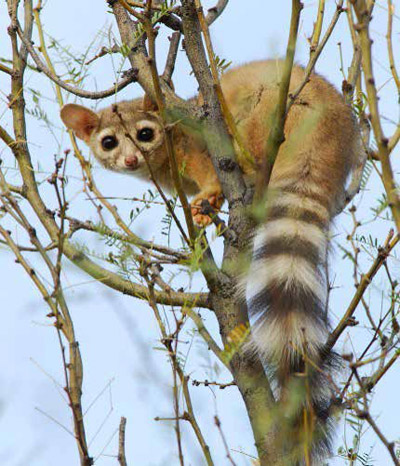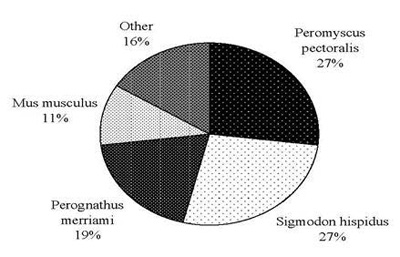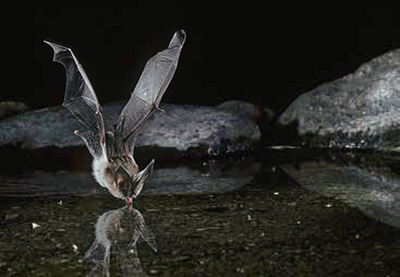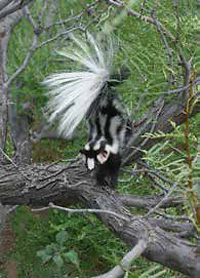Amistad National Recreation Area (NRA) is positioned near the boundary of three biotic regions—Chihuahuan Desert, Edwards Plateau, and Tamaulipan Shrublands—and includes the confluences of the Rio Grande, the Pecos River, and the Devils River. Mammals have been studied both before and after the reservoir was constructed from the 1960s-1980s. However, no comprehensive mammalian inventory had been conducted within the park.
This project had four objectives: (1) document the current mammal fauna; (2) assess any changes that have occurred in species found within the park since the previous studies were conducted; (3) establish permanent transects to allow park personnel to monitor changes in animal populations over time; and (4) determine the distribution of the various mammals within Amistad NRA.
Methods

© Blake Trester
To document the current mammal fauna, trap sites were located across the park in each of nine habitat types. Small mammals were surveyed at each of these sites with 100 small, metal live traps (Sherman traps) placed along two trap lines (transects). Nine additional transects were sampled for medium and large mammals. A minimum of one night of netting was conducted to sample bats at each of nine sites. Additional records were obtained through observations, collecting in specific habitats (e.g., rocky bluffs, abandoned tunnels, and other sites), salvaging road kills, recording sign, and recording echolocations (acoustic data) of bats. Fieldwork was conducted from May 2003 to July 2004. Museum collections and literature records were checked and compiled to complement trapping results and provide a comprehensive checklist of mammals.
Results

Small Mammal Survey—Twelve species of rodents, totaling 160 individuals were captured during this study. The whiteankled mouse (Peromyscus pectoralis) and the hispid cotton rat (Sigmodon hispidus) both comprised 27% of the total number of captures. The house mouse (Mus musculus), which is generally associated with people, made up a surprising 11% of all captures (Figure 1).
Medium and Large Mammal Survey—Six species of medium-sized mammals were trapped during the study. Species caught were Virginia opussum (Didelphis virginiana, n=6), ninebanded armadillo (Dasypus novemcinctus, n=2), ring-tailed cat (Bassariscus astutus, n=2), raccoon (Procyon lotor, n=8), striped skunk (Mephitis mephitis, n=2), and western spotted skunk (Spilogale gracilis, n=1). One juvenile desert cottontail (Sylvilagus audubonii) was captured. Twelve additional species were identified using other methods (firearms, visual surveys, track or scent, road kills): black-tailed jackrabbit (Lepus californicus), eastern cottontail (Sylvilagus floridanus), beaver (Castor canadensis), porcupine (Erethizon dorsatum), coyote (Canis latrans), gray fox (Urocyon cinereoargenteus), western hognosed skunk (Conepatus mesoleucus), collared peccary (Pecari tajacu), white-tailed deer (Odocoileus virginianus), domestic cat (Felis catus), mouflon sheep (Ovis aries orientalis), and Barbary sheep (also known as aoudad, Ammotragus lervia).

© Merlin Tuttle, Bat Conservation International
Bat Survey—From May 2003 to July 2004, five species were captured during ten nights of mist (very fine) netting. Species caught (in order of decreasing abundance) were cave myotis (Myotis velifer, n=10), Brazilian free-tailed bat (Tadarida brasiliensis, n=7), pallid bat (Antrozous pallidus, n=5), Yuma myotis (M. yumanensis, n=5), and western pipistrelle (Pipistrellus hesperus, n=2). One night of harp trapping (a special trap especially useful at cave or mine entrances) resulted in 155 T. brasiliensis and 21 M. velifer being captured live. A colony of western mastiff bats (Eumops perotis) was documented by visual identification at a roost site, and one Townsend’s big-eared bat (Corynorhinus townsendii) was observed and collected at a roost site. Twelve species were identified during five nights of acoustic recording with an Anabat II detector. The seven species documented exclusively through this method were ghost-faced bat (Mormoops megalophylla), eastern pipistrelle (Pipistrellus subflavus), evening bat (Nycticeius humeralis), hoary bat (Lasiurus cinereus), big free-tailed bat (Nyctinomops macrotis), pocketed free-tailed bat (Nyctinomops femorosaccus), and one unidentified species of bat.
Museum Records—Museum collections accounted for nine species not documented during the study that may currently occur within Amistad NRA. The following species were confirmed through museum records: least shrew (Cryptotis parva), desert shrew (Notiosorex crawfordi), Botta’s pocket gopher (Thomomys bottae), desert pocket mouse (Chaetodipus eremicus), Merriam’s kangaroo rat (Dipodomys merriami), northern grasshopper mouse (Onychomys leucogaster), deer mouse (Peromyscus maniculatus), fulvous harvest mouse (Reithrodontomys fulvescens), and the non-native black rat (Rattus rattus).
Discussion

© Doug Burkett
This survey documented 50 mammal species at Amistad NRA, and found literature records that support the occurrence of an additional 17 species. The current work has added several previously undocumented species to the mammal fauna of Amistad NRA. The northern pygmy mouse (Baiomys taylori), cactus mouse (Peromyscus eremicus), rock pocket mouse (Chaetodipus intermedius), evening bat, big free-tailed bat, pocketed free-tailed bat, and black bear (Ursus americanus) are native species that were undocumented by the previous studies. With the exception of the northern pygmy mouse, evening bat, and pocketed free-tailed bat, none of the native mammals captured during this study appear to be expanding their range, and the increase in total species is probably an artifact of increased sampling in and around Amistad NRA. Amistad NRA has a very diverse bat community. Of the 33 species found in Texas, 16 can be expected in the vicinity of the park. Protection of roosting sites should be a management priority. There are several non-native animals now present in Amistad NRA: black rat, nutria (Myocastor coypus), feral domestic cat, feral pig (Sus scrofa), mouflon sheep, and Barbary sheep. The presence of these mammals, along with the house mouse, in the park, can be attributed directly to humans. These animals can negatively impact native species. Park personnel need to take a proactive approach to managing these species to limit destruction of native flora and fauna, as well consider removal of all non-native animals. The carnivores that might occur in and around the park are the least documented mammalian group, and further research is warranted to better manage and conserve these species.
Prepared by the Chihuahuan Desert Network Inventory and Monitoring Program, 2013.
Last updated: November 25, 2018
